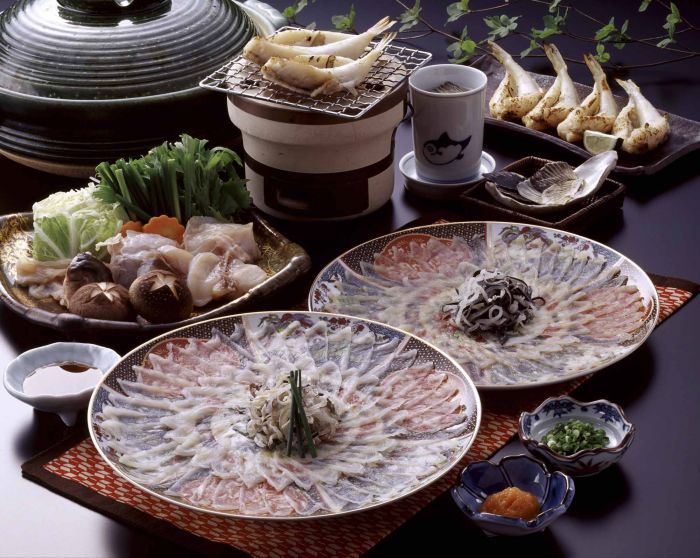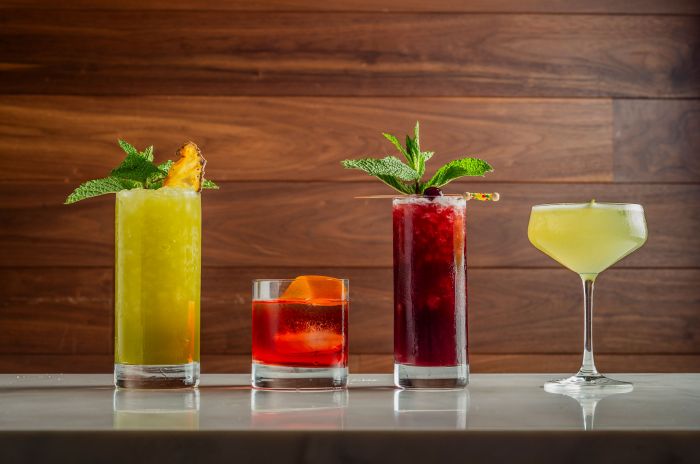
When it comes to food, a little danger not only enhances the taste, but also gives you an amazing story to regale your friends and family with. While plenty of dishes are risky for various reasons, there are a few that present a much more intense challenge—some widely known (like puffer fish) and others a little more obscure (like casu marzu). It’s important to remember that while sampling these foods may seem like a crazy way to fill your bucketlist, they are steeped in rich cultural significance and should be approached with respect. After all, when a food can kill you, you should probably take it seriously and do some research so you don’t end up in the hospital…or worse.

Fugu
It’s pretty widely known that fugu (puffer fish), which is priced around $200 a pound, is a popular Japanese delicacy that can kill you if it’s not prepared just right. Fugu goes back centuries, with bones having even been found in burial mounds from 10,000 BC, and was even banned for periods of time due to its danger. Only highly-trained, certified chefs should ever prepare the dish, because the puffer has toxic organs that contain tetrodotoxin, which will cause asphyxia if consumed. To give you a sense of just how nasty the toxin is, it is apparently 1,200 times more deadly than cyanide and because it doesn’t actually enter into the blood-brain barrier, you won’t even know your central nervous system is shutting down until it’s too late. There isn’t an antidote, so the best course of treatment is to support the respiratory and circulatory systems while the poison makes its way through the body.
With the ovaries, liver and intestines being the most poisonous, eating the fish has been compared to Russian roulette and must be skillfully prepared. Though the number of fatalities have dropped with the rise of certified restaurants and chefs (only around 35 percent of applicants actually reach certification), they still happen for a variety of reasons—including diners specifically ordering liver, because they want to live on the edge (not recommended). Of course, people wouldn’t be risking their health for poor-tasting foods, so it makes sense that the meal is considered incredibly tasty (with the most lethal organs supposedly tasting the best). If you are in the mood for life-endangering adventure, just make sure to do your due diligence in selecting a restaurant with a certified chef.

Sannakji
Running for $30-40 for a small container, sannakji is a raw Korean delicacy that stars nakji (baby octopus). Because the octopus is cut into pieces while still living and served immediately with sesame oil, it retains active nerve endings and can be seen to wiggle on the plate. The danger comes in when the tentacles are swallowed and suction to the sides of the throat, causing a serious choking hazard (eek!).
Not without controversy, animal rights organizations are against the dish due to the method in which the octopus is prepared. In 2010, PETA stressed that "octopuses are complex, intelligent animals who have a rich life, the ability to learn quickly from observation, and highly evolved brains similar to those of vertebrates." Though the complaint isn't unfounded, Korean establishments stress that though the nakji does appear alive, it's not.
Since you should be extra careful when eating sannakji, we obviously recommend doing it sober.

Casu Marzu
If you have a sensitive stomach, you may want to skip this one. Seen as an aphrodisiac and cultural staple to the Sardinians, casu marzu is a unique cheese made from sheep milk. Known for its soft, creamy texture, the cheese is coveted because it’s only made in certain regions. It’s also controversial and has a history of being outlawed in Europe due to health code violations, causing it to fetch up to $500/pound on the black market.
Basically, after the sheep milk cheese is made, it is left outside so flies can lay eggs inside of it. After they hatch and the maggots eat the cheese, they pass it through their digestive tract (which breaks down the fat and gives a creamy texture) and casu marzu is created. (We did warn you.) Though some people pick the maggots out, most don’t bother and eat them along with the cheese and a strong glass of red wine. Things get risky if the maggots don’t die upon ingestion, because they can cause a lot of damage to your intestinal walls and even lay eggs. The cheese is said to be more than worth the risk though, carrying an incredibly rich taste that is one-of-a-kind. It’s also considered an aphrodisiac, because the maggots literally leap from the cheese when disturbed (people actually shield their eyes).

Ackee
This strange fruit is native to West Africa and a major staple in Caribbean dishes—especially in Jamaica, where it is the national fruit. While the tree isn't indigenous to Jamaica, it ended up being grown in large amounts after being imported on slave ships and is now symbolic of the country. Ackee is treated more like a vegetable than a fruit though, and is typically cooked with salted cod and onions—some say it tastes like cheese and others insist eggs. Though it is incredibly popular, you should never pick your own unless you know what you’re doing. The ackee can’t be unripe or overripe and the rind, membrane and seeds are all poisonous. Actually, the only edible part of ackee is the pulp around the seeds. The illness associated with the fruit is called “Jamaican vomiting sickness” and can actually be fatal to some within 24 hours.
Because of the risk, the FDA set standards and certification requirements for Jamaican companies who export ackee to North America, ensuring that the fruit has been perfectly and expertly canned.

Elvers
Elvers, also known as glass eels, are tricky to catch. Everything from temperature to bad weather can cause their numbers to drop significantly, making elvers a tough industry. With fishing season in Maine starting on March 29, fisherman are hoping that the warm weather will lead to a bigger haul than last year, when they only caught 5,300 pounds of the little eels (the quota is 10,000 pounds). Naturally, value goes up when yield is low and last season saw prices upwards of $2,200 per pound for the little eels The Economist calls "transparent gold"—for reference, Kobe beef is worth around $500/lb and blue fin tuna goes for around $1,300/lb.
Not only tough to source, they’re also tricky to prepare. Similar to fugu, elvers can be toxic when eaten, able to cause internal cramping and sometimes heart failure. Though a single eel is tiny, it has enough poison in it to kill a rabbit—so imagine a bowl full of them. To avoid the health risk, elvers have to be thoroughly cooked, so eating it raw is a big mistake.














